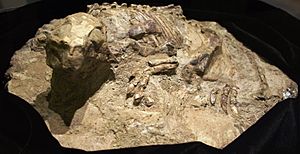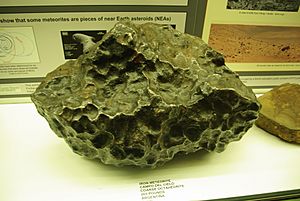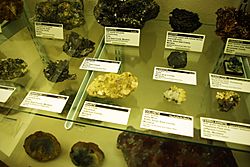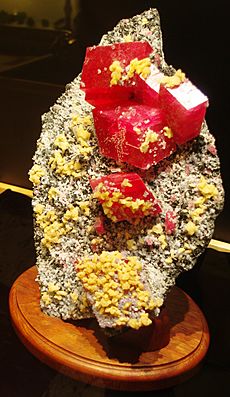Rice Northwest Museum of Rocks and Minerals facts for kids
 |
|
| Established | 1996 |
|---|---|
| Location | Hillsboro, Oregon, U.S. |
| Type | Earth sciences |
| Visitors | approx. 25,000 (2009) |
The Rice Northwest Museum of Rocks and Minerals is a special museum in Hillsboro, Oregon, USA. It's located near the Sunset Highway, just outside Portland. This museum is all about earth science, which means it teaches you about rocks, minerals, and how our planet works.
The museum officially opened in 1997. However, its amazing collections of rocks and minerals started way back in the 1930s. The museum is actually inside a home that was built specifically to show off these collections. This unique ranch-style house is so important that it's listed on the National Register of Historic Places. In 2015, the museum became a Smithsonian Affiliate, connecting it to the famous Smithsonian museums.
The museum sits on 23 acres (about 9 hectares) of wooded land. The main building has 7,500 square feet (about 700 square meters) of space. You can see all sorts of cool things here, like petrified wood, different fossils, glowing fluorescent minerals, meteorites, and many other types of minerals. With over 20,000 items, it's the biggest museum of its kind in the Pacific Northwest. About 25,000 people visit the museum every year.
Museum History

The story of the museum began with Richard L. Rice and Helen Hart. They got married in 1932 and started collecting rocks in 1938. Their first finds were agates along the Oregon Coast. In 1952, the Rices built a new home north of Hillsboro on 30 acres (12 hectares) of land. This home later became the museum.
The Rices started a small museum in 1953 to show their growing collections. Their collections were so good that they won the Woodruff Trophy twice, in 1958 and 1961. Helen Rice was even the president of the American Federation of Mineralogical Societies from 1959 to 1960.
In 1996, the Rices officially created the non-profit museum. Richard and Helen Rice both passed away in 1997. Their home and collections then became part of the museum. The Rice Northwest Museum of Rocks and Minerals officially opened its doors to the public in 1997.
In June 2000, the museum added 94 pieces of crystallized gold from the F. John Barlow collection. In 2001, a new exhibit opened, focusing on the lapidary arts, which is the art of cutting and polishing stones. By this time, the museum had more than 4,000 items.
A new gallery for petrified wood opened in January 2003. In 2004, the museum displayed 52 meteorites from the Cascadia Meteorite Laboratory at Portland State University. This exhibit was supported by NASA. By 2004, about 15,000 people visited the museum each year.
In 2005, scientists found the fossilized remains of a thalattosuchian crocodile from the Jurassic period in Central Oregon. The museum plans to display these fossils after they are studied. Later in 2005, the 1,800 square foot (167 square meter) Northwest Minerals Gallery opened. This gallery was once a storeroom, but it was renovated for $150,000.
By 2007, the museum welcomed 25,000 visitors each year, with many coming from school groups. The museum's collection grew to more than 20,000 items by 2010. About 18,000 of the annual 25,000 visitors were from school field trips. In December 2023, a collection of gold items was stolen from the museum.
Amazing Collections
The Rice Northwest Museum is the largest of its kind in the Pacific Northwest. It holds more than 20,000 items. These specimens come from all over the world. Many were even dug up by the Rices themselves. One expert, Bill Dameron, said the museum has the best mineral specimens in the Pacific Northwest.
The collections include beautiful gemstones, minerals, fossils, meteorites, and some ancient tools. You can see rubies, diamonds, rhodochrosite, opal, emerald, and amethyst gemstones. The fossils include shark teeth, coprolites (fossilized animal waste), petrified wood, dinosaur eggs, trilobites, and even a baby dinosaur fossil called Psittacosaurus. About 1,000 of the museum's items are so small that you need a microscope to see them clearly.
One special area is the Rainbow Gallery. This gallery shows off rocks and minerals that glow in the dark. They have phosphorescent or fluorescent elements. An automatic system uses special ultraviolet lights to make the rocks glow.
A large part of the petrified wood collection came from Dennis and Mary Murphy. Their collection has over 450 items. It includes a huge log of white oak that weighs 1,200 pounds (about 544 kilograms). This log came from Eastern Oregon and is thought to be more than 25 million years old. The museum's petrified wood comes from Oregon, Washington, and even as far away as Argentina and Australia. Other fossils include ancient cycads, palms, and ferns.
A main attraction is the "Alma Rose" rhodochrosite from the Sweet Home Mine in Colorado. The Alma Rose has crystals up to 9.5 centimeters long. It also has quartz and calcite crystals that make it sparkle. The Rices once owned another famous rhodochrosite called the "Alma King" from the same mine. They sold it to the Coors Brewing Company, which then gave it to the Denver Natural History Museum. The Rices had bought both stones for $800,000.
The museum also has a collection of 107 gold pieces from the F. John Barlow collection. These include a 42-ounce (1.2-kilogram) gold leaf. Some pieces were mined from the Ace of Diamonds mine in Liberty, Washington. One of the museum's pieces, a sperrylite from Russia, is considered one of the best in the world.
Other items on display include fossilized animal waste from Mongolia. There's also a 500-pound (227-kilogram) piece of lightweight volcanic rock called pumice. You can also see obsidian and basalt. One amazing specimen is a 30-centimeter wide plate with clear quartz crystals and epidote crystals. It comes from Green Monster Mountain on Alaska's Prince of Wales Island.
The collection also has a cycad fossil from the Jurassic era that weighs 500 pounds (227 kilograms). A large meteorite on display is the Gibeon meteorite. It weighs 210 pounds (95 kilograms) and came from Namibia in Africa. The museum is also home to the world's largest known opal-filled thunderegg. It weighs 1.75 tons (about 1,600 kilograms). The thunderegg is Oregon's state rock. Other cool items include azurite, Oregon sunstone, amber, copper crystals, zeolites, morganite, and agate.
Museum Programs
The Rice Museum offers many programs for the public. It used to have a summer festival with activities like thunderegg cutting and gold panning demonstrations. The museum has also hosted the Northwest Fossil Fest. The museum offers tours for school groups and other community groups. These events will start again when the museum has more staff and funding.
Museum Facilities
|
Richard and Helen Rice House
|
|

Front of the home in 2010
|
|
| Built | 1952 |
|---|---|
| Architect | William F. Wayman |
| Architectural style | Ranch |
| NRHP reference No. | 06001096 |
| Added to NRHP | November 29, 2006 |
The museum and its grounds are located north of the Sunset Highway. This is west of Portland, between the Helvetia Road and Jackson School Road exits. The museum sits on 23 acres (9.3 hectares) of mostly forested land. It is housed in the historic Richard and Helen Rice House. This building was originally built as a family home.
The house was finished in 1952. It was built with Arizona flagstone on the outside. Inside, it features wood native to Oregon, like curly maple and myrtlewood. William F. Wayman designed the house, and Victor Batchelar built it. Charles F. Walters designed the beautiful grounds around the home. Richard Rice, who was a logging contractor, cut and milled all the wood used in the house himself. The home was designed so that its basement could be used as a museum for the Rices' collections.
The house has three sandstone fireplaces. The kitchen counters are made with hand-painted tiles from Mexico. Myrtlewood is used for trim and doors inside the house. The bedroom closets have built-in drawers, shelves, and ironing boards. The two-level building also has cool features like dumbwaiters and a sewing room. Outside, raked cedar was used on the eaves of the low-pitched roof. The exterior sandstone is tan, rose, and blue.
The 7,500 square foot (700 square meter) home has a 3,300 square foot (307 square meter) basement. It cost $185,000 to build. In 2021, the museum's flooring was replaced after a flood. However, the original blue linoleum in the basement, which has the museum's logo, was saved. This ranch style home was the first ranch home in Oregon to be listed on the National Register of Historic Places.
Besides the main house, the museum also uses a separate building as a gallery. This building, called the Northwest Gallery, used to be a storage area and shop. It looks similar to the Rice House. This gallery focuses on items from Oregon, Idaho, and Washington. It includes collections of agates, thundereggs, zeolites, and placer gold. Before the museum opened in 1997, an elevator was added to the main house.
The museum has several special rooms. These include a Community Room, a Resource Library, a Fossil Gallery, and the Rainbow Gallery. There are also Special Exhibits, an Education Room, a Petrified Wood Gallery, a Main Gallery, and the Pacific Northwest Gallery. You can also find a gift shop. Outside, there's a walk with sandstone and basalt columns. There's also a 1,200-pound (544-kilogram) rock made of pumice. Don't forget the Rock Pile activity, where visitors can even take a rock home!
See also
- Classic Aircraft Aviation Museum
- Next Level Pinball Museum
- Five Oaks Museum





